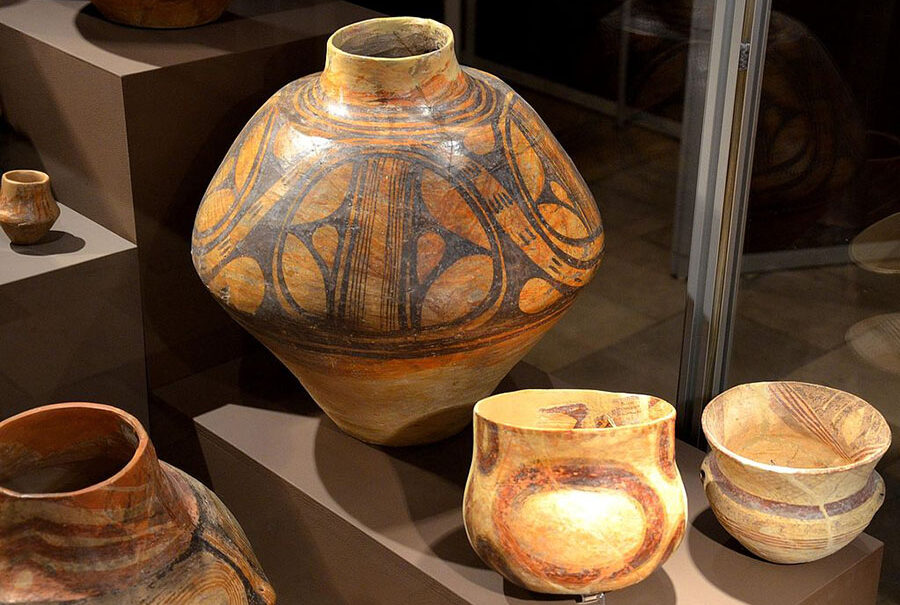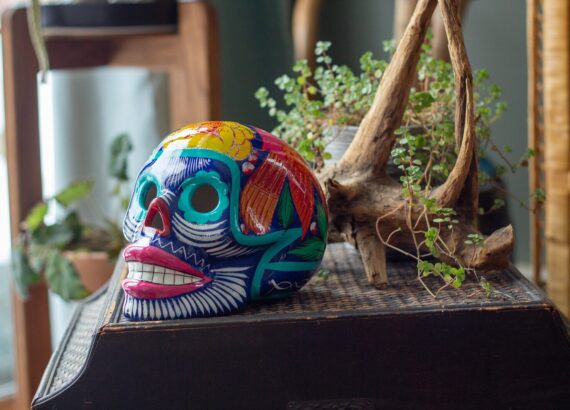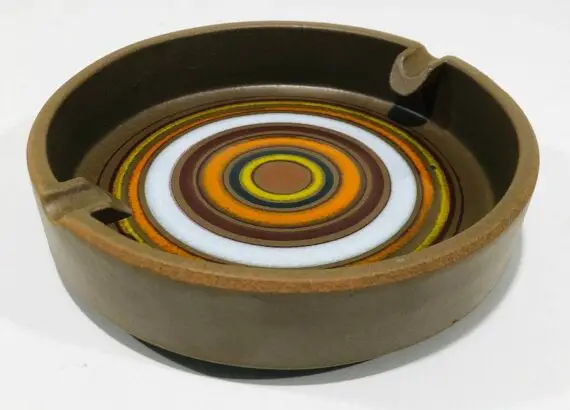Neolithic Pottery History: 3 Types of Neolithic Pottery

Human evolution is described and appreciated through periods or ages which are defined by the way of life of the people and the technologies and pieces of machinery. Such types of machinery define the day-to-day living in these periods and thus mean they are a defining point of such period in which they are prevalent.
The neolithic period refers to the Stone Age’s final stage, which was first recognized around 12000 years ago. This was the beginning of farming, and it continued until the Chalcolithic period. The name Neolithic refers to the ‘New Stone Age,’ which describes the types of crafts and artifacts that characterize this time.
The history of humanity is littered with breakthroughs and inventions. One of the earliest major innovations to have a substantial impact on people’s lives and society was pottery. By the Neolithic Age, clay modeling as it relates to pottery had taken on a life of its own. They were used to convey water and food, as well as for religious ceremonies and cooking.
Table of Contents
Neolithic Pottery Technology and Techniques
The emergence of farming, according to archaeologists, enabled the need for robust and substantial systems to convey water for irrigation. Great communities would have needed to build up stockpiles of cereals like sorghum, rice, and wheat, as well as ceramics to store these surpluses.
During the Early Neolithic period, between 6,500 and 5,800 B.C., artifacts were burnished or monochrome with the shape of open bowls and were of exceptional quality.
As time progressed, the pots appeared to be incised, stamped, and painted with decoration. Its residents built the world’s first spectacular display of handcrafted ceramics. This can be seen, for example, in Thessalian pottery.
Clay goods were adorned with red paint over a light backdrop or the other way around during the Middle Neolithic period, commonly known as the “Sesklo Culture.” The three traditional designs were combined as variations of zigzag lines, flame patterns, and linear lines. During this time, the “scraped” style of decoration evolved.
This Late Neolithic era, also known as “Dimini Culture,” included a diverse range of pottery kinds and styles, ranging from grey or black monochrome to painted decoration with a black color on a red burnished backdrop.
The phases are as follows, in chronological order: Classical Dimini (black on white paint and intricately engraved pottery), Tsangli (grey), Larisa (black burnished), Arapi (polychrome), Otzaki (white on red), Agia Sophia (black on red), and Tsangli (grey).
Around 4,500-3,300 B.C., the Final Neolithic period, also known as the “Rachmani Phase,” began. Instead of building handles for the monochrome clay goods, they employed horn-like lugs on the vases. They also employed a thick paste instead of paint to embellish.
The Chalcolithic period began at 4,500 B.C., followed by the Bronze Age at 3,500 B.C., during which copper or bronze was predominantly utilized as the major hard substance for the creation of tools and weapons, signaling the end of the Neolithic period.
Types of Neolithic Pottery
Neolithic pottery features three main types of ceramic ware which include;
- Earthenware: The simplest and oldest type of pottery is earthenware. It’s also the softest because it’s heated at the lowest setting (typically between 1000 and 1200 degrees Celsius). Maiolica, faience, and delft are among the materials used.
- Stoneware: Stoneware is a thicker, higher-temperature-fired kind of pottery (between 1100 and 1300 degrees Celsius). Stoneware is also commonly covered with a powdered glass glaze and refired at a higher temperature. The glaze fuses with the clay body, resulting in a vitreous, impenetrable surface.
- Porcelain: Porcelain is finer than stoneware, produces a ringing tone when tapped, and has a characteristic translucence when held up to the light. Chinese Porcelain is the finest and most precious variation.
Neolithic Chinese Pottery
Around ten or eleven thousand years ago, the first ceramics manufactured in China were utilitarian objects, and the value of basic pottery has never diminished. Neolithic tribes in the Yellow and Yangtze river valleys used fanciful thin-walled, painted, and polished earthenwares, some of which had sophisticated designs, as ritual vessels well before the Bronze Age.
According to Joy of Museums Virtual Tour, in China, the Neolithic Age dates back to around 10,000 BC. Excavation of a Peiligang culture site in Henan revealed a population that thrived between 5,500 and 4,900 BC, with traces of agriculture, built structures, ceramics, and burying of the dead.
These red, grey, and black largely handcrafted artifacts generally display exceptional craftsmanship and beauty for their age. After bronze, lacquer, and precious metals were mastered, ceramics lost their ritual status, and ceramic shapes began to mimic metal shapes almost as soon as the latter arrived.
Neolithic African Pottery
The oldest known pottery in Africa is made in Sub-Saharan Africa. Swiss scientists uncovered ceramic sherds dating back to at least 9500 BCE in Ounjougou, Central Mali, in 2007. Pot-making has long been associated with the spread of Bantu languages in this part of Africa, but there has been little research on the topic.
Khartoum Hospital and Shaheinab, the two categories of the Khartoum Mesolithic and Khartoum Neolithic, respectively, are two important pottery sites in Central Sudan. Sherds of pottery from funerary vessels were discovered in burial trenches alongside skeletal remains at these locations. Wavy line and dotted wavy line ornamentation distinguished the vessels.
Another Neolithic ceramics site in Africa is the Takarkori rock cover in the Acacus piles of southern Libya, wherein British archaeologists found earthenware shards dating from 5200 BCE.
Different locales have uncovered bits of ceramics returning to 3000 BCE in the semi-parched Sahel line district between the Sahara desert and tropical Africa (enveloping bits of Gambia, Senegal, Mauritania, Mali, Algeria, Niger, Nigeria, Cameroon, Chad, Sudan, and Eritrea).
Egyptian faience, non-dirt-based earthenware idealized by Egyptian ceramicists, even though it started in Ur, Mesopotamia, is ostensibly the most popular assortment of African stoneware. The world’s soonest known faience studio, furnished with refined lined block ovens, was found in Abydos, Egypt, tracing back to 5500 BCE.
Quartz/sand precious stones were squashed joined with calcium, magnesium, potassium, sodium, and copper oxide to make Egyptian Faience.
From that point forward, the glue was shaped into structures and consumed.
Greek Neolithic Pottery
Antiquated stoneware accomplished its apex in the creation and beautifying of jars, amphoras, and different ancient rarities in traditional Greece. The establishments of Greek brightness might be followed back to the period 3000-2000 BCE when Aegean workmanship overwhelmed Thessaly as the main ceramics community.
Recent trends of earthenware from the Cyclades, for example, the Sesklo product, including its mathematical plan and marine themes, additionally added to this Aegean renaissance. Minoan stoneware was popular all around the Mediterranean. Mycenaean workmanship, which supplanted Minoan culture after the Mycenaeans vanquished Crete around 1400 BCE, was disillusioning.
Then, at that point, in the twelfth century BCE, attacking clans from the north attacked Greece, bringing about the breakdown of expressions and artworks in many pieces of the country.
Except for the White Ground method, Greek earthenware from the Classical Period (c.480-330 BCE) was a disappointment. With fewer possibilities for experimentation, the medium was becoming flat.
Indian Neolithic Period
During the Mehrgarh Period II (5500-4800 BCE), Neolithic earthenware was utilized in India as right on time as 5500 BCE, especially in current northwest India and Pakistan. [The aceramic Mehrgarh I culture (7000–5500 BCE)] During the Merhgarh Period III (4800-3500 BCE), earthenware progressed substantially more, especially during the Indus Valley Civilization, which thrived around the Indus River and Ghaggar-Hakra streams.
This human progress, otherwise called the Harappan Civilization after the sort site Harappa in Punjab, thrived from around 3500 to 1300 BCE and went through five times of earthenware fabricating. It was prevailed by Iron Age Indo-Gangetic customs of “painted dark earthenware” and “northern dark cleaned product” around 1300 BCE.
Japanese Neolithic Period
After Chinese ceramics, antiquated Japanese fired earthenware, recognized as Jomon Pottery, is the second most established kind of artistic. The Neolithic time frame is likened to the “Jomon” time of Japanese workmanship, which signifies “rope-designed” in Japanese, following the squeezing of examples into the dirt.
The most punctual Japanese vessels (Incipient Jomon culture) were uncovered around 14,540 BCE at the Odai Yamamoto I site in Aomori Prefecture. Shards of old Japanese ceramics have additionally been found in caves on the northwest bank of current Kyushu, dating from 12,700 BCE, and at the Kamino site in southwestern Japan, dated from 14,000-13,000 BCE.
Since the potter’s wheel wasn’t developed at this point, all Jomon pots were made by hand. Mica, lead, filaments, and broken shells were utilized to mix the earth with an assortment of increments. Instruments were utilized to clean the surfaces of the earth piece after it had been delivered. From that point forward, it was dried and warmed in a huge fire at around 900 degrees Celsius.
There are five unique sorts of Jomon ceramics:
• “Fukabachi” earthenware production (containers, profound dishes);
• “Hachi” (medium-profundity bowls);
• “Asabachi” (shallow dishes);
• “Tsubo” (holders with long necks and restricted lips); and
• “Chuko” (compartments with long necks and limited mouths) (holders with spouts). Jomon stoneware was principally utilized for putting away food.
Korean Neolithic Pottery
Comb pottery, commonly known as comb ware, was the most common ceramic style in Korea during the Neolithic Period (c. 3000–700 BCE). The earthenware is constructed of sandy clay and is generally reddish-brown, and it is based on a Siberian Neolithic predecessor. A simple V-shape jar with a pointed or rounded bottom can be found in early comb pottery.
The whole surface is coated in small, slanting, and parallel impressed or incised lines that are organized in horizontal or vertical rows to form a comb pattern.
The clay is typically tempered with asbestos or talc stone in later pottery, and the base of the vase is flattened. The older, space-filling linear style gives way to dot-based curved forms that are sparingly dispersed. The pottery was first imported to Kyushu, Japan, where it gave rise to the so-called Sobota pottery, which was a combination of comb and the local Jomon ceramics.
British Neolithic Pottery
British Neolithic pottery is described with the name Grooved ware. According to TheBritishMuseun, Grooved Ware is a Late Neolithic ceramic style that was popular in the United Kingdom and Ireland. It has a flat base and can be embellished or left simple. Depending on the sub-style, this can be done in a variety of ways, such as grooving, incision, imprint, and applied or other plastic ornamentation, all of which are ornamental techniques.
Grooved Ware was more popular in the larger and more recent settlements, such as Skara Brae and Barnhouse, because of its flat bottom and complex ornamentation of scored grooves. The Grooved Ware people began to bury their deceased in cairns that grew larger and more monumental, such as Maeshowe.
Philippines Neolithic Pottery
This is widely called Pinagmulan pottery. Filipino pottery could be used for a variety of purposes. Pottery was manufactured for water vessels, plates, cups, and a variety of other purposes in the Philippines throughout the Neolithic period. Anthropomorphic motifs were painted on other pottery used to retain the remains of the deceased.
The vessel coverings of these anthropomorphic clay pots were formed like human heads and dated from 5 BC to 225 A.D. Archaeological evidence from the Neolithic Period revealed that people’s lifestyles had altered dramatically since earlier times. It was obvious that people were more concerned with the shape of stone tools.
Polished stone tools, especially blade-like implements, stone adze, shell adze, and red slipped pottery, began to emerge from archaeological sites.
Conclusion
The development of human living and existence is entrenched in innovations and inventions. This is the driving force for the creations of something out of nothing which describes the artistic brilliance of Neolithic pottery. Valid thought around the preservation of life and life-sustaining materials, especially food, led to the creation of pottery vessels, which differ in material used and design from place to place.




